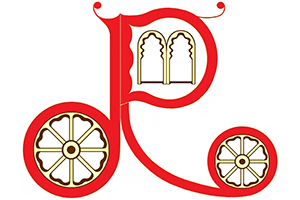SPIRITUAL SANCTUARY, CAPTIVATING CULTURE AND BREATHTAKING SCENERY; TIBET, CHINA
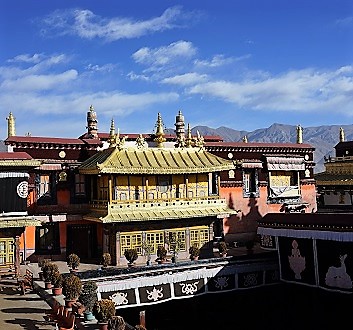
China, Tibet, Jokhang Temple
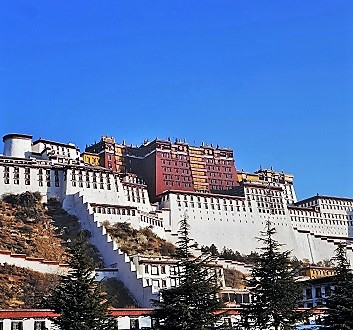
China, Tibet, Potala Palace
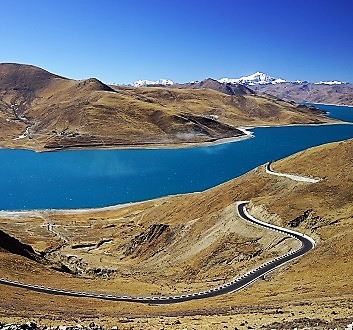
China, Tibet, Yamdrok Lake
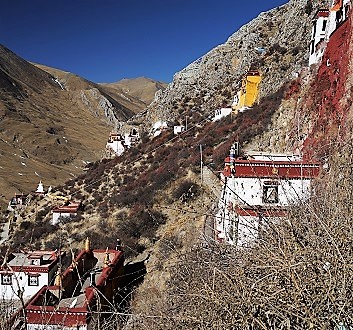
China, Tibet, Drak Yerpa Meditation Caves
Travel Itinerary
Day 1 – Arrive Lhasa, Tibet
There are direct flights to/from Lhasa, Tibet from Beijing, China. There are non-stop flights from the USA and Europe (main international hubs) to Beijing, China. At Lhasa Gonggar Airport, we meet our tour guide and driver and transfer to our hotel. Upon our arrival to the hotel, we check-in and visit the oxygen lounge, enabling our gradual adjustment to the high altitude. In the evening, we dine in our hotel at the Shu Garden Restaurant, serving Tibetan and Chinese specialties.
Note: We advise sufficient time to plan the trip to Tibet. Foreign visitors to Tibet require a Tibet Tourism Bureau permit and a China visa. Foreign tourists must book a tour in order to obtain a Tibet Tourism Bureau permit. Our recommended travel agency in Tibet, Tibet Highland Tours (tibethighlandtours.com/contact), provides the necessary permits and manages our preferred Tibet Itinerary. We arrange a 7-day private tour (private SUV car, tour guide, experienced driver) with a travel agency in Tibet, then book our flights and hotel. We stay at the Shangri-La Hotel Lhasa for the duration of our trip, taking full-day excursions to the important and beautiful places in Tibet. Tibet’s landscape is widely different in the summer (high season) and in the winter (low season). There are fewer tourists in the winter, offering peaceful time to visit Tibet’s sacred places and observe devout Tibetan people. We travel to Tibet during the winter season, defined by amazing blue skies, sunny days, dry terrain and cold winter temperatures. We recommend packing warm winter clothes, obtaining a prescription medication for altitude sickness and preparing for non-western style toilets. During our full-day excursions outside Lhasa, we drink less liquids to minimize/avoid using the sub-standard toilets in Tibet. The Tibetan Plateau is a wild, beautiful and spiritual place. The visitors to Tibet shall prepare for an adventure and for minor changes to the itinerary, due to the weather and other changes that may occur in this beautiful but very remote area of the world.
Day 2 – Jokhang Temple, Barkhor Circuit, Drepung Monastery
In the morning, we drive around 20 minutes to the center of ancient Lhasa, to visit the Jokhang Temple and observe the Tibetan pilgrims praying in the Barkhor Square. The Jokhang Temple showcases prayer chapels, Buddha statues, a spacious courtyard and magnificent views of the Potala Palace from the rooftop. After visiting the temple, we walk along the Barkhor Circuit, observing the traditional Tibetan architecture and Tibetan pilgrims continuing their spiritual pilgrimage. We spend time at the ancient Barkhor Street, visiting souvenir shops and sampling the Tibetan cuisine. After lunch, we drive half an hour (around 10 kilometers) from Lhasa to the base of the Mount Gephel to visit the Drepung Monastery, a spiritual sanctuary constructed in 1416 by Jamyang Choeje Tashi Palden. We visit the Main Assembly Hall decorated with traditional Tibetan Buddhist paintings and listen to the monks chanting their prayers. Afterward, we drive half an hour to our hotel and have dinner.
Day 3 – Samye Monastery, Sand Dunes
Our excursion to Samye Monastery takes us across the Tibetan Plateau, defined by picturesque villages, winding Yarlung Tsangpo River, mountainous terrain and magnificent sand dunes. We depart at 8:00 am and drive 2.5 hours (around 150 kilometers) to the beautiful valley in the Shannan Region, location of the Samye Monastery. Along the way, we stop to photograph the eye-catching sand dunes landscape. The Samye Monastery, Tibet’s first Buddhist monastery, was constructed in the 8th century by the Tibetan King Trisong Detsen. We admire the Giant Mandala representing the Buddhist universe and the Wuzi Hall symbolizing Mount Meru. The monastery’s beautiful chambers, chapels, statues, murals and painted wooden architecture offer a history lesson of Tibetan Buddhism. After the visit, we explore the nearby village and have a simple lunch at a local restaurant. We drive 2.5 hours back to our hotel and enjoy a relaxing dinner.
Day 4 – Potala Palace, Norbulingka Palace, Sera Monastery
Our excursion starts at 8:00am with a 20 minutes’ drive to the Potala Palace, a winter palace of the Dali Lama. We walk among the thousands of Tibetan people making the pilgrimage and circling the Potala Palace. The steep stone staircases guide visitors to the courtyards, chapels and the palace. The Red Palace shows shrines, chapels and the Great West Hall decorated with murals. Inside the White Palace, we visit the Great East Hall, administrative quarters and past living quarters of the Dali Lama. The imposing Potala Palace celebrates the Tibetan artistry and spirituality. After our visit, we drive 15 minutes to the Norbulingka Palace, the 18th century summer palace of the Dali Lama. We explore the expansive 36 hectare park, chapels and palaces, including the most beautiful one, the Dadan Mingjur Palace. In the afternoon, we have lunch at a local restaurant serving delicious Tibetan cuisine. After lunch, we drive 20 minutes to the Sera Monastery to observe exuberant monks debating the Tibetan Doctrines with gestures and words. Later, we return to our hotel for dinner.
Day 5 – Yamdrok Lake, Tibetan Villages
We spend the full-day traversing the Tibetan Plateau and visiting the Yamdrok Lake, considered as Tibet’s holiest lake. We depart Lhasa at 8:00am and take a picturesque route (approximately 4 hours) along the winding Yarlung Tsangpo River, traditional Tibetan villages and mountainous terrain. We traverse the Gambala Pass at 4,900 meters, admiring spectacular views of snow covered mountain peaks and the beautiful Yamdrok Lake. We drive to the base of the lake, featuring a peaceful beach, colorful Tibetan prayer flags and majestic Tibetan Yaks. We have lunch by the lake, consisting of food prepared at our hotel. In the afternoon, we start our journey back to Lhasa, passing Tibet’s beautiful countryside and wild terrain. We have dinner in our hotel.
Day 6 – Drak Yerpa Meditation Caves, Ganden Monastery
In the morning, we drive an hour (approximately 30 kilometers) to the Yerpa Valley to visit the Drak Yerpa Meditation Caves. We walk from the parking lot and follow a winding pathway to the limestone cliffs at the altitude of 4,000 meters, to explore the secluded meditation retreat for Tibetan pilgrims and monks. We walk together with a continuous stream of Tibetan pilgrims visiting these ancient caves. After the visit, we eat a quick lunch we brought from our hotel. We drive around 1.5 hour (approximately 50 kilometers) to the Ganden Monastery, situated by the Wangbur Mountain. At the Ganden Monastery, we follow a walkway to the Main Assembly Hall, observe the traditional Tibetan spiritual symbols and admire panoramic views of the mountain and the picturesque valley. At the end of the day, we depart the monastery and drive approximately 1.5 hour to our hotel in Lhasa for dinner.
Day 7 – Lhasa Shopping, Relaxation Day
Today, we take time to relax and browse for souvenirs. After breakfast, we drive to ancient Lhasa and spend a few hours shopping and having lunch along Barkhor Street. A wide selection of souvenirs awaits visitors to Lhasa, such as Tibetan carpets, hand-made jewelry, Tibetan clothing, traditional incense, hand painted Thangka paintings and spiritual symbols. After lunch, we return to our hotel and have a blissful and relaxing the rest of the day.
Day 8 – Lhasa Departure
We enjoy a wonderful breakfast buffet, relax in our hotel and depart at noon toward Lhasa Gonggar Airport for our departure flight.
Note: Our Tibet, China Itinerary may be used separately or combined with our Chengdu & Harbin, China Itinerary. Option 1: Fly to Beijing, China to take an international flight home. Option 2: Extend the journey one week to explore Chengdu and Harbin in China. Take a direct flight from Lhasa, Tibet to Chengdu, China.
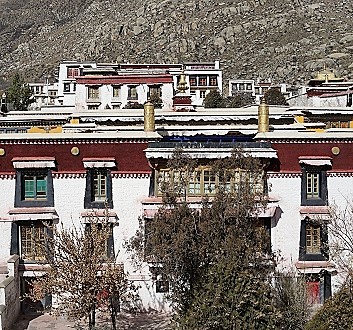
China, Tibet, Drepung Monastery
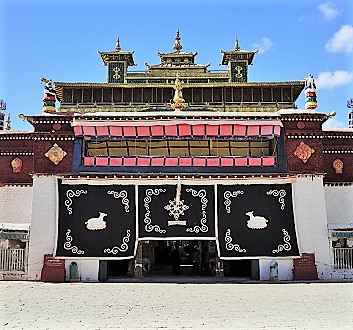
China, Tibet, Samye Monastery
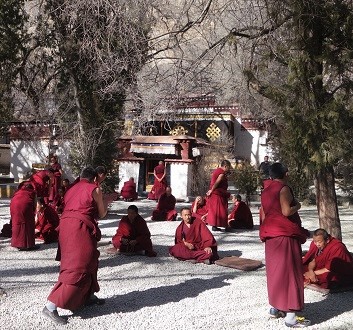
China, Tibet, Sera Monastery
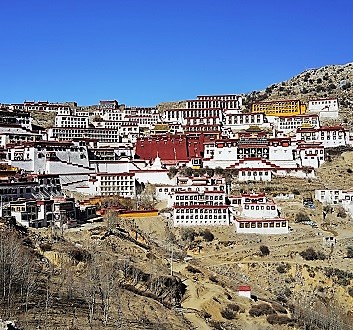
China, Tibet, Ganden Monastery
Special Places
Tibet – Tibet Autonomous Region, called Tibet, is a province-level autonomous region in China. Tibet exemplifies beauty in nature with its snow-capped mountains, picturesque valleys, turquoise lakes, winding rivers and desert topography. Situated between the Himalayan Mountains to the south and the Taklamakan Desert to the north, the Tibetan Plateau is the world’s highest region and encompasses Tibet. Lhasa, the capital of Tibet, is situated in the center of the Tibetan Plateau. Lhasa, revered as a spiritual pilgrimage destination, has astounding palaces, sacred monasteries and schools of Tibetan Buddhism. Tibet is an extraordinary place of indescribable beauty, profound spirituality, unique culture, turbulent history and peace loving Tibetan people. Traversing Tibet, we follow in the footsteps of the Tibetan people and observe countless manifestations of Tibetan Buddhism. The devout pilgrims make their spiritual journey, chanting their prayers and circumambulating the sacred monasteries and temples. We observe mountains adorned with the prayer flags, monks dressed in traditional red robes and Tibetan people living a simple life. The traditional Tibetan villages showcase white stone houses, native yaks grazing in the highlands and yak dung (dry manure) used as fuel for cooking and heating the houses. Tibet is the land of unspoiled culture and traditions passed down through generations.
Jokhang Temple and Barkhor Circuit – A walk through ancient Lhasa by the preserved architecture of the Barkhor Square guides visitors to the spiritual Jokhang Temple, showing praying Tibetan pilgrims. The construction of the Jokhang Temple began in the year of 647 A.D during the reign of Tibetan King Songtsan Gampo. Jokhang Temple is located in the ancient part of Lhasa in the Barkhor Square and is a UNESCO World Heritage Site and is considered a sacred place by Tibetans. Jokhang Temple is a four-story structure with two golden deer statues surrounding a Dharma Wheel atop the roof. The temple consists of prayer chapels, Jowo Rinpoche Buddha statues (the sacred statue in Tibet), a spacious courtyard and a pathway to the rooftop offering spectacular view of the Potala Palace. The Barkhor Circuit represents a circumambulation of the Jokhang Temple for Tibetan pilgrims, a spiritual route lined with four large incense burners. The circumambulation, known as Kora, represents a spiritual annual pilgrimage for all Tibetans who often start the grueling pilgrimage from far away parts of Tibet. The ancient Barkhor Street enchants not only with its colorful Tibetan culture and spirituality, but also with its traditional Tibetan architecture, quaint shops and restaurants.
Drepung Monastery – A pathway along the Tibetan Prayer Wheels and the views of Lhasa guide Tibetan pilgrims to the Drepung Monastery. Situated within 10 kilometers from Lhasa at the foot of Mount Gephel, the Drepung Monastery is a spiritual sanctuary with an impressive architecture. The monastery, constructed in 1416 by Jamyang Choeje Tashi Palden, is part of six main temples and an important Gelugpa Scholastic Institution of Tibetan Buddhism. The monastery’s Main Assembly Hall shows the distinct Tibetan décor, such as traditional thangkas (Tibetan Buddhist paintings illustrating Tibetan spiritual scenes or mandalas on fabric), fabric covered columns and monks’ prayer area with sitting pillows and red robes. The Drepung Monastery’s white façade is accentuated with red color at the top and golden yellow symbols.
Samye Monastery and Sand Dunes – A sweeping scenery of mountains, rivers and sand dunes guides us to the picturesque valley and the jewel of Tibetan Buddhism. The scenic 170 kilometer route from Lhasa to Samye Monastery reveals the natural beauty of the Tibetan Plateau. We admire the simple Tibetan village life, mountainous topography, winding Yarlung Tsangpo River and magnificent sand dunes landscape. Situated in the picturesque Yarlung Tsangpo Valley in the Shannan Region, the Samye Monastery is Tibet’s first Buddhist monastery and symbolizes the birth of Tibetan Buddhism. The monastery was constructed in the 8th century by the Tibetan King Trisong Detsen. It showcases a Giant Mandala representing the Buddhist universe and the Wuzi Hall symbolizing the Mount Meru (sacred mountain). The monastery features Tibetan artistry, beautiful chambers, chapels, statues, vivid murals, painted wooden architecture and pagodas displayed at each corner. The Samye Monastery is a sacred pilgrimage destination and a teaching institution.
Potala Palace – Elevated at the altitude of 3,700 meters on the Marpori (Red Mountain), the Potala Palace visually manifests Tibet’s intriguing spirituality, vibrant culture and interesting history. The Potala Palace, a UNESCO World Heritage Site, was built in 637 A.D. by the Tibetan King Songstän Gampo and became a political, religious and residential palace of the Dali Lama. The Potala Palace covers 13 stories and includes 1,000 rooms with living quarters, temples, tomb stupas and monk dormitories. The Potala Palace encompasses the grand palace structure and the surrounding park, designed with trees, flowers and stone staircases leading to courtyards and chapels. The Potala Palace’s façade has distinct multiple sections, visually recognized by their white, yellow and red colors. The Red Palace, mainly a Buddhist prayer and learning center, hosts spiritual shrines, chapels and the Great West Hall decorated with expressive murals. The White Palace displays two expansive wings with white colored façade symbolizing peace. It hosts the Great East Hall where important religious events took place, administrative quarters and the past living quarters of the Dali Lama.
Norbulingka Palace – In the west part of Lhasa, a wonderful park filled with flowers, trees, ponds, and temples serves as a beautiful setting for the Norbulingka Palace, a summer palace of Dali Lama. Situated at a short distance from the Potala Palace, the Norbulingka Palace (means Treasure Park in Tibetan language) is a splendid summer residence and historic center. The palace, a UNESCO World Heritage Site, was originally constructed in the 18th century by the 7th Dali Lama Kelsang Gyatso. The expansive 36 hectare park showcases cultural relics, historic palaces, spiritual chapels and aesthetically designed gardens. The most beautiful palace, the Dadan Mingjur Palace (known as New Summer Palace), was constructed in 1965 and contains 30 uniquely decorated chambers, including sleeping quarters, reading rooms and chapels.
Sera Monastery – The tree lined cobblestone walkway along an ancient Tibetan architecture leads to the central courtyard surrounded by the remarkable structures of the Sera Monastery. The Sera Monastery (Sera means “Wild Rose” in the Tibetan language) was developed by Jamchen Choje Shakya Yesh in 1419 and encompasses the Gelugpa teaching institution (Gelugpa represents a branch of Tibetan Buddhism). This historic relic consists of the Coqen Hall (Assembly Hall) exhibiting vivid murals, three colleges and dormitories. Located on the northern outskirt of Lhasa, the Sera Monastery attracts many visitors who come to observe the Tibetan monks’ debate sessions scheduled at fixed times. The exuberant monks debate the Tibetan Doctrines through animated gestures and words. They challenge their comprehension, practice their convictions and aspire to advance their education.
Yamdrok Lake and Tibetan Villages – The dramatic landscape of snow covered mountain peaks and tranquil valley is a perfect backdrop for the beautiful Yamdrok Lake. The Yamdrok Lake lies at the altitude of 4,450 meters and is considered as Tibet’s holiest lake, revealing glittering turquoise waters surrounded by sublime natural scenery. A few hours’ route from Lhasa to Yamdrok Lake passes the winding Yarlung Tsangpo River, traditional Tibetan villages with white stone houses and native yaks grazing in the highlands. Traversing the Gambala Pass at 4,900 meters, we observe the spectacular views of the enclosed valley, sweeping mountains and shimmering turquoise waters of Yamdrok Lake. The scenic route continues to the base of the sacred lake, featuring a peaceful lakeside beach and colorful Tibetan prayer flags blowing in the wind. Majestic Tibetan Yaks and Tibetan Mastiffs (a native dog breed) are made available along the Yamdrok Lake for photos. Traversing Tibet’s countryside, we observe picturesque villages with white stone houses, decorated with multi-colored window frames and colorful spiritual symbols.
Drak Yerpa Meditation Caves – Wide-ranging mountainous terrain surrounds the picturesque Yerpa Valley and shelters the meditation caves. The 25 kilometers’ scenic route northeast from Lhasa guides visitors to the spiritual Drak Yerpa Meditation Caves at the altitude of 4,000 meters. In the limestone cliffs, the Drak Yerpa Meditation Caves serve as a secluded meditation retreat for Tibetan pilgrims and monks. The meandering pathway proceeds a steady climb to the steep limestone cliffs housing the unique meditation caves. The devout pilgrims recite their mantras as they peregrinate toward the meditation caves and through the designated mountain routes. These ancient caves and monastery served in the past as a Tibetan Buddhist teaching center and retain the memories of the turbulent history of China’s Cultural Revolution.
Ganden Monastery – A steep Wangbur Mountain and a beautiful valley create a magical setting for the sacred Ganden Monastery. The Ganden Monastery, situated approximately 50 kilometers from Lhasa, was originally built in 1409 A.D. by Tsongkhapa. The monastery was severely damaged and later was partially rebuilt. The Ganden Monastery is a national cultural relic and serves as a Gelugpa teaching institutions (Gelugpa is a branch of Tibetan Buddhism). The narrow walkways enable us to observe the monastery’s impressive design, traditional multi-colored décor and symbolic Tibetan ornaments. The Ganden Monastery’s Main Assembly Hall displays a traditional white and red structure with gold ornaments atop the roof. The spectacular architecture and tranquil mountain setting inspire a continuous influx of pilgrims and tourists to visit this spiritual and beautiful monastery.
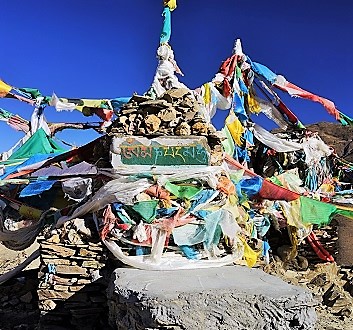
China, Tibet, Tibetan Prayer Flags
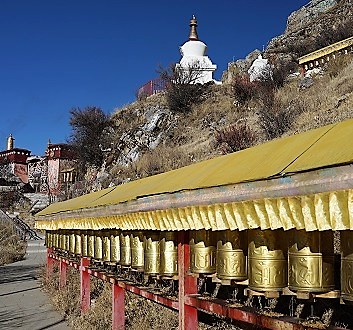
China, Tibet, Drak Yerpa Meditation Caves, Prayer Wheels
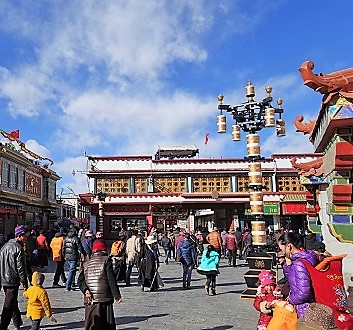
China, Tibet, Barkhor Circuit
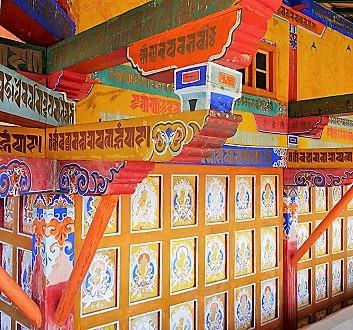
China, Tibet, Samye Monastery, Colorful Interiors
Favorite Adventures
Tibetan Traditions – Tibet is the land of sacred pilgrimage, spiritual mantras, profound meditations and expressive artistry. Tibetan Prayer Flags date back to ancient times before the introduction of Buddhism to Tibet. The introduction of Buddhism coincided with significant changes in the Tibetan culture coming from neighboring Nepal, India and China. Tibetan Buddhism brought an era of spiritual devotion, lessons of compassion and messages of peace. Buddhist monks transcribe spiritual mantras, pictures and symbols on the flags, representing blessings and prayers. The Tibetan Prayer Flags come in five colors, each color expressing a meaning: blue-sky, white-clouds, red-fire, green-water and yellow-earth. The colorful flags hang on mountain tops, in the valleys along the sacred lakes, carrying the messages of peace. Tibetan Prayer Wheels, originally brought to Tibet by an Indian Buddhist teacher, reflect centuries of traditions practiced by Tibetan Buddhists. The Tibetan Prayer Wheels come in variety of styles and sizes, hand held or as large prayer wheels displayed nearby the Buddhist stupas and monasteries. The spiritual mantras, placed inside the prayer wheels, carry prayers and positive messages. The Tibetan pilgrims spin the prayer wheel clockwise and recite their mantras to develop a positive state of mind. The Tibetan Pilgrimage, known as Kora, involves the circumambulation of monasteries, sacred lakes, spiritual mountains and demonstration of respect to the holy person. The Tibetan pilgrims complete their pilgrimage walking or with full body prostrations as they spin prayer wheels, chant mantras or count rosary beads. Tibetan pilgrims, young and old, demonstrate incomparable spiritual devotion, when they set out for their annual spiritual journey from many parts of Tibet, enduring many hardships. Throughout Tibet, ancient monasteries showcase Tibet’s traditions and spirituality in the Tibetan Art. The Tibetan artisans continue the traditions of creating vivid religious paintings, wooden furniture, weaved carpets and elaborate structures. Magnificent wooden ceilings show multi-colored designs, floral motifs and distinct Buddhist symbols. Thangka Paintings are traditional Tibetan paintings created on cotton or silk and depicting Buddhist scenes. The Tibetan furniture is embellished with traditional themes, such as floral motifs, animal designs and religious symbols. The tradition of designing Tibetan carpets with many colors and motifs, existed in ancient Tibet. The authentic Tibetan carpets follow ancient hand-weaving techniques and use the wool of the Tibetan highland sheep. A journey across Tibet reveals the fascinating and colorful Tibetan culture and traditions, celebrated and preserved everywhere in Tibet.
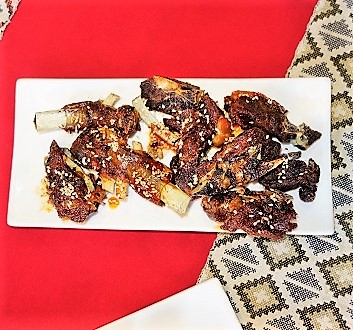
China, Tibet, Spicy Lamb Chops
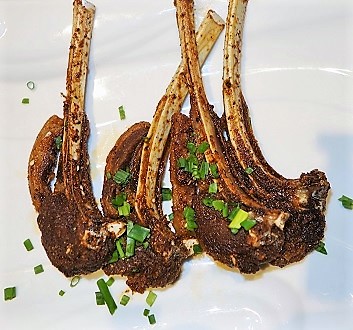
China, Tibet, Lamb
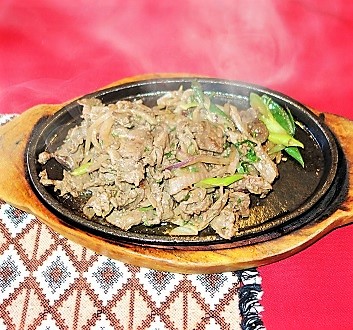
China, Tibet, Yak Meat
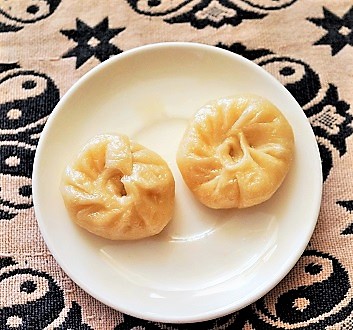
China, Tibet, Cheese Momo
Selected Cuisine
Tibetan Cuisine – Tibet’s diverse topography, harsh climate and neighboring countries influence the Tibetan cuisine. Tibet’s wild terrain consists of a small percentage of arable land, making raising animals the primary agricultural activity. The wild Tibetan Plateau and preserved agricultural traditions contribute to the high quality of the Tibetan meats. As we explore Tibet, we sample delicious Spicy Lamb Chops served with sesame seeds, enhancing the flavors. Grilled Yak Meat on Pebble Stones, another staple meat of Tibetan cuisine, delivers subtle flavors and tender texture. The Tibetan cuisine also includes a variety of flavorful noodles topped with meat and dumplings filled with various meat and non-meat delicacies. The Cheese Momo, a Tibetan and Nepalese specialty, is a dumpling stuffed with a lightly sweetened white cheese. Chhurpi, a traditional Himalayan cheese, is Momo’s primary stuffing and has soft texture, white color and unique flavor.
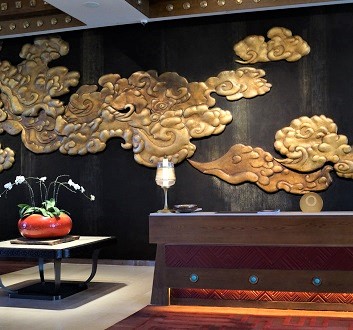
China, Tibet, Shangri-La Hotel Lhasa
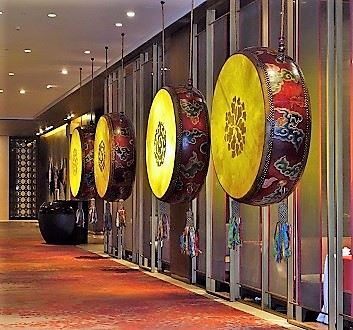
China, Tibet, Shangri-La Hotel Lhasa
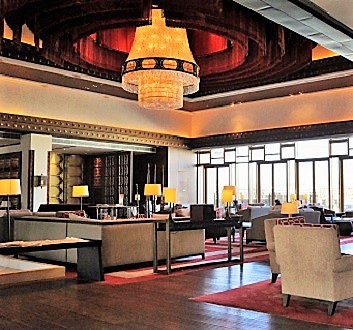
China, Tibet, Shangri-La Hotel Lhasa
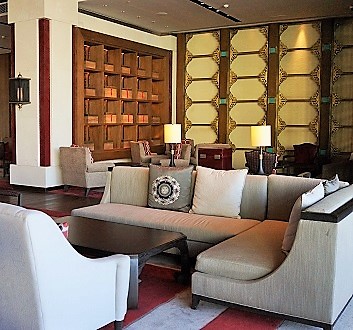
China, Tibet, Shangri-La Hotel Lhasa
Preferred Accommodations
Shangri-La Hotel Lhasa – We select the Shangri-La Hotel Lhasa because of its elegant décor, Tibetan style, inviting ambiance and close proximity to the Potala Palace. The spacious lobby creates a relaxing atmosphere and an oxygen lounge provides the perfect setting for our gradual adjustment to the altitude. The recommended Premier Potala View King Room situated on the higher floor offers a side view of the Potala Palace (Room 476). The hotel’s interiors are decorated with Tibetan art, unique symbols and soothing colors. In the morning, the Altitude Restaurant welcomes its guests with a splendid breakfast buffet consisting of a multi-cultural cuisine. Our preferred evening dining choices are the Altitude Restaurant serving Tibetan, Indian, Chinese and Western cuisine, and the Shu Garden Restaurant serving an authentic Sichuan Cuisine, Tibetan dishes and Cantonese specialties. The Shangri-La Hotel Lhasa is an idyllic location to experience the beauty and spirituality of Tibet.
